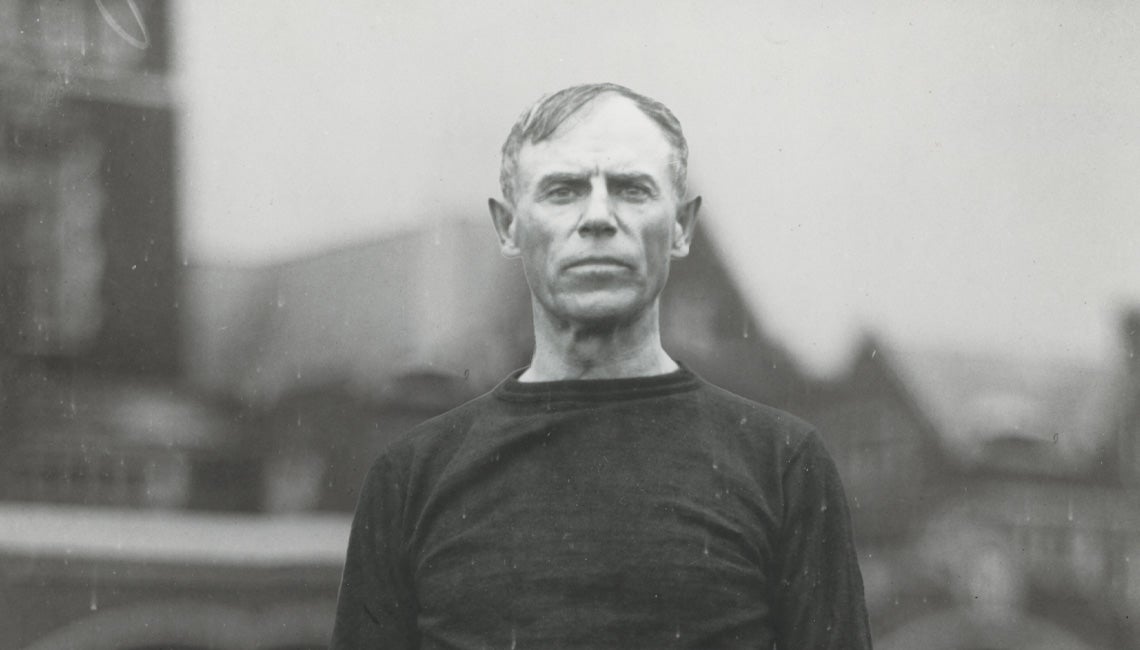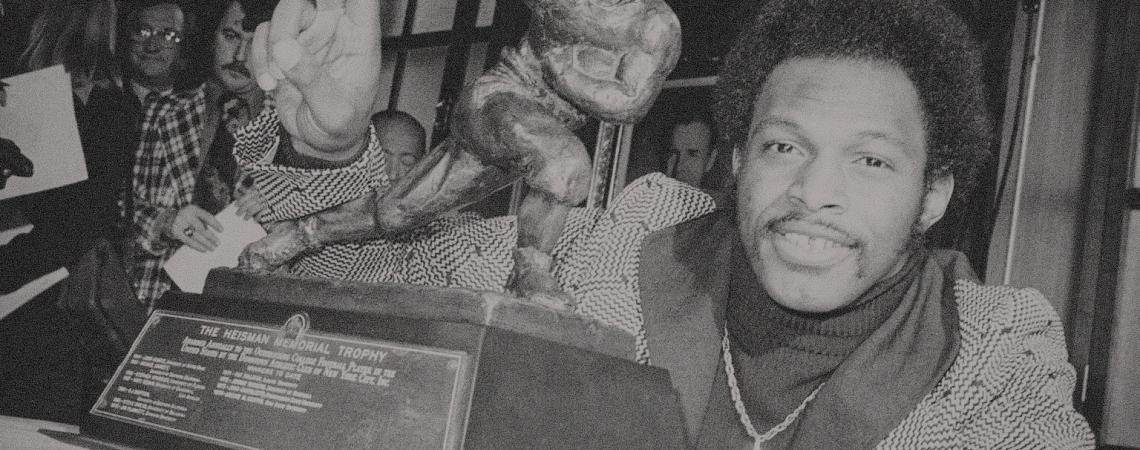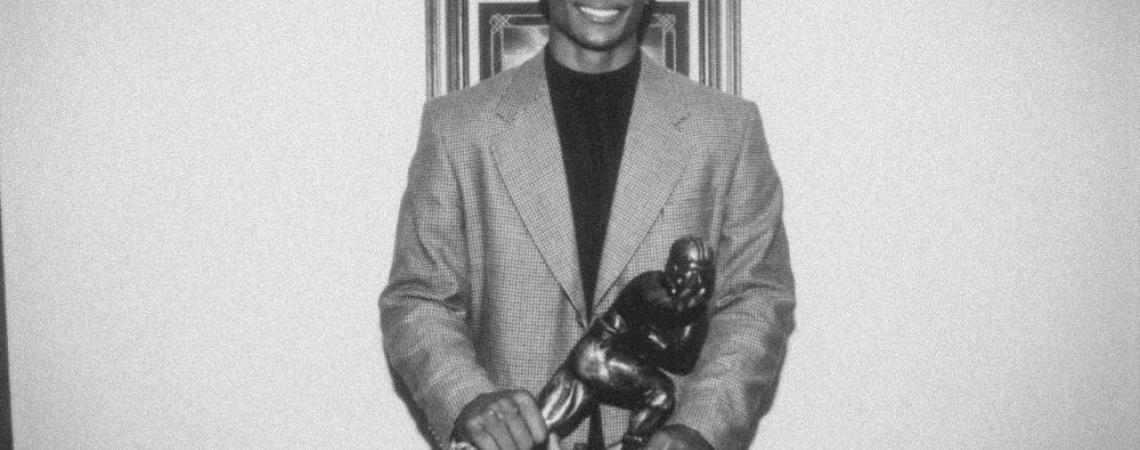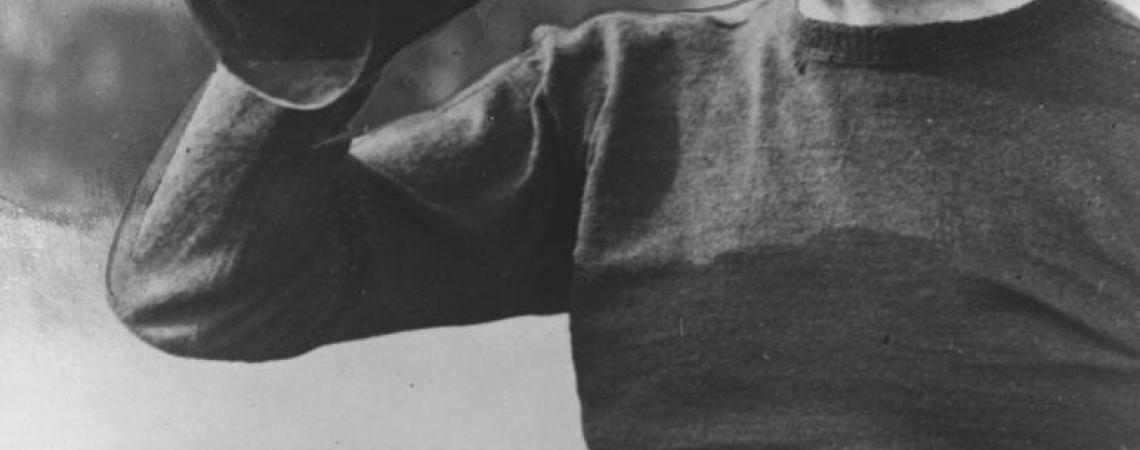Most college football fans in the Buckeye State hear the word “Heisman” and think immediately of the six Ohio State University players who have won the sport’s most prestigious award — most notably, perhaps, of Archie Griffin, still the only player to win the Heisman Trophy twice.
Some might also know that five other Heisman winners were born in Ohio (and that doesn’t include 2019 winner Joe Burrow, who played for Athens High and briefly attended OSU but was in fact born in Iowa).
But with the approach of the 90th anniversary of the first award in 1935, only the most trivia-minded will know the famed trophy’s true Ohio connection.
The Heisman Memorial Trophy is presented annually in December to the nation’s outstanding college football player - pictured here is Archie Griffin.
John W. Heisman himself, the renowned innovator and Hall of Fame coach — the award’s namesake — was born in Cleveland in 1859. And though he grew up in Titusville, Pennsylvania, and played football for Brown University and the University of Pennsylvania, his first coaching jobs were at Oberlin College in 1892 (a season in which the Yeomen beat Ohio State not once but twice, by a combined score of 90–0) and Buchtel College, which is now the University of Akron.
“John Heisman was a pioneer and one of the most important names in college football,” says Denis Crawford, a historian and exhibit designer at the College Football Hall of Fame in Atlanta. “Pop Warner is top level; Walter Camp is an all-American. But Heisman is a name you’re going to remember for as long as they give out this award.”
The Heisman Memorial Trophy is presented annually in December to the nation’s outstanding college football player. When it was first awarded by New York City’s Downtown Athletic Club in 1935, to University of Chicago running back Jay Berwanger, it was called simply the DAC Trophy. The following year, however, its name was changed to honor the club’s late athletic director, who had overseen the creation of the award: none other than the retired coaching legend, John W. Heisman, who died on October 3, 1936.
Why did Heisman deserve that honor, one that has not only withstood the test of time, but becomes more prestigious with each passing year? In a word, says Crawford, excellence. Some of Heisman’s “innovations” have become the most basic elements of today’s game; without them, it’s unlikely that college football would be the exciting, entertaining spectacle it is today.
He was the first, for example, to start offensive plays with a snap from center and the first to have players shift positions before the start of the play. He designed the earliest version of the reverse, a double-handoff play designed to get the defense moving the wrong way; his “hidden ball” play was basically an extremely well-executed precursor to the fake handoff. And while he didn’t actually invent the forward pass (it was first used by accident in a game he was scouting), it was only through his advocacy that the play became legal in 1906. He even invented the practice of posting the score, down, and yards to go on a scoreboard.
His early success at Oberlin drew the attention of some powerhouse teams in the South, and he was hired to coach the Alabama Polytechnic Institute (now Auburn University) in 1895 and at Clemson five seasons later. His most prolific period was during his time at Georgia Tech, where he arrived in 1904. He stayed for 16 seasons, turning the school into a national football powerhouse whose 1915, 1916, and national champion 1917 teams were unbeaten.
One of the wins in 1916, a 222–0 triumph over Cumberland, was said to be revenge for an earlier 22–0 win by the Cumberland baseball team over the Heisman-coached Georgia Tech team. It remains the largest margin of victory in college football history.
During the offseasons, Heisman managed a summer stock theatrical company and traveled around the South giving performances.
John M. Heisman, the coach’s great-nephew, remembers returning home for a holiday visit in 1972 and finding his father, William, with travel trunks full of old manuscripts, newspaper clippings, and photographs. A minister in Rhinelander, Wisconsin, had found the trunks, packed them and their contents in protective plastic, and shipped them to their owner’s nearest living relative. The trunks had belonged to the legendary coach, who had been married to a Rhinelander native and so was laid to rest in the northeastern Wisconsin town.
“When I was growing up, my father told me stories about my [great-] uncle John and used them as life lessons,” John says. He spent the entire next summer sorting and reading the contents, but in the fall of 1973, he went back to Ohio State to finish his degrees, and the trunks went to the back burner.
Fast-forward to 1984, when John was settled in Toledo and decided to return to the contents of the trunks. He wrote more than 400 pages, whittled away at the book, and polished it. A friend connected John with book publisher Simon & Schuster and introduced him to Mark Schlabach, an investigative reporter and bestselling author, who helped him frame and flesh out its narrative.
Published in 2012, Heisman, the Man Behind the Trophy is still in print. It not only covers the coaching career of his great-uncle, but also tells stories about some of the coach’s other passions — for example, Heisman also was a Shakespeare enthusiast, actor, and theater producer who appeared in dozens of plays during and after his coaching career, many to rave reviews.
“I appreciate being able to tell his story,” John says. “Everybody is gaga about the trophy, but there is so much more Americana in Coach Heisman’s story. What happened before the Trophy was much more important.”












